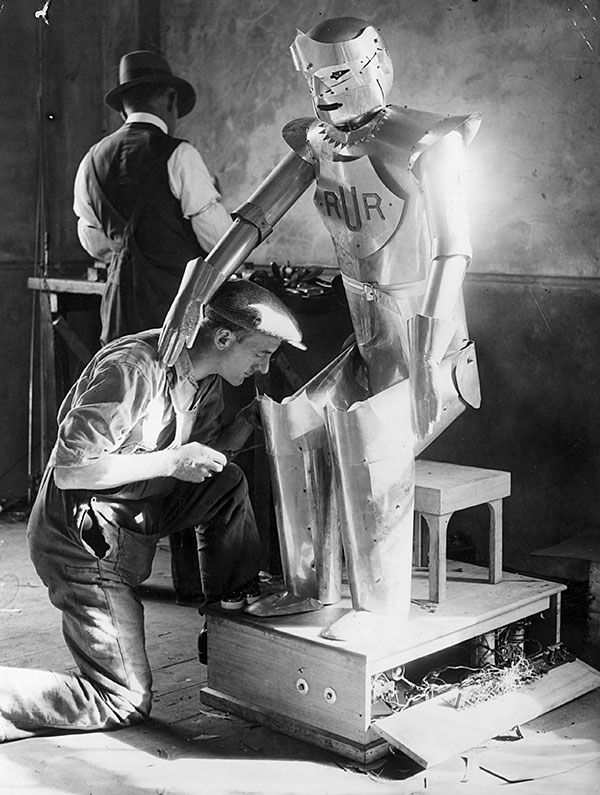Eric, Asimov and me: or how to stop worrying and love robots
Simply sign up to the Technology sector myFT Digest -- delivered directly to your inbox.
I first became aware of Eric about 20 years ago when my disabled uncle — seeking to divert himself from permanent discomfort — sent me an email with a picture of a metal man, something like a knight from the days of yore, with the letters R.U.R. on his chest. Uncle asked if I knew what it was.
While Eric was new to me, R.U.R. was not. As a student of early 20th-century drama, I had in my teens come across R.U.R. (Rossum’s Universal Robots) — the play by Czech writer Karel Capek for which the word “robot” was coined to describe man-made, subservient artificially intelligent beings. What surprised me then — and ever since — is that most people, many of whom know far more than I about robots, have never heard of the play or realised that the word did not exist before 1920. In the play — spoiler alert — humanity is wiped out by robots who then seek to develop emotions and become the new humanity.

Eric, it seems, was nothing to do with R.U.R. but an automaton who could seemingly answer questions put by his creators. It was of course a stage trick rather than an early example of AI.
I always assumed Eric had been built by mountebanks trying to cash in on R.U.R.’s success, although it seems he was made to publicise a mechanical engineering show. He was an overnight hit and went on a world tour in 1928 but suddenly vanished. His metallic remains have never been found.
R.U.R. was also a worldwide success. It appeared on US radio in the 1930s and the BBC televised it in 1938, but like Eric it too has been largely forgotten.
My uncle died last year and, while clearing out his stuff, I came across a first US edition of Capek’s play I had given him one birthday. This contained photos of a 1920s’ stage production that reminded me of Eric, but otherwise I had forgotten the robot completely.
So I was surprised while on my way home from work one night in May to find a feature about Eric in London’s Evening Standard newspaper. The London Science Museum is planning a big exhibition about robots in 2017 and has opened a Kickstarter crowdfunding campaign to raise £35,000 to rebuild Eric. As I write, it has had pledges of £13,000.
Science-fiction author Isaac Asimov, considered an authority on robots, began writing about them when R.U.R. was still well known. He said there were three kinds of robotic tale: robot as menace, robot as pathos and — his own take — tales of “industrial products built by matter-of-fact engineers”. R.U.R., the parent of all robotic fiction, is all three, and its prediction of mass-produced human-like machines that do our work seems stunningly prescient.
While one cannot use fiction to predict the future, I have been reading Asimov to try and gain some philosophical insight into how we might respond to robots: as a species, as individuals, as employees and workers. R.U.R. has merits but is a stilted, stiff drama by modern standards and its dystopian view has influenced other, better-remembered works, such as Fritz Lang’s 1927 film Metropolis, that present a dim view of robots and AI.
Asimov’s tales waver between menace and pathos perhaps more than he would have liked to admit. In the background there often is the US Robots and Mechanical Men, Inc, churning out machines to perform tasks from being companions to mining or visiting threatening aliens. This gives his stories a base in something like real capitalism, if you do not look closely.
As well as automated cars, Asimov, who died in 1992, predicted robots that could write and edit, and computers that get bored running big organisations and mess their human operators around for light relief (the daily computer crash explained). He also devised the three laws of robotics:
1. A robot may not injure a human being or, through inaction, allow a human being to come to harm.
2. A robot must obey orders given it by human beings except where such orders would conflict with the First Law.
3. A robot must protect its own existence as long as such protection does not conflict with the First or Second Law.
The apparent common sense of having some laws governing our future AI-equipped helpmates gives one the hope that, at some point, global policymakers might consider what the dawn of the robots really means for us.
I do not get the feeling from Asimov’s tales that robotics is good or bad. It just is. Some characters manipulate robots, others are afraid of them, some robots go wrong. But the future he envisages in the stories I have read so far seems more hopeful than the crepuscule of R.U.R. If a rebuilt Eric is ever able to answer for himself, I can only hope he will agree.
Comments